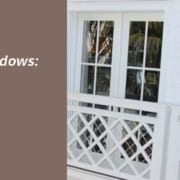The Real Mahogany: Architectural Specifications for Genuine Mahogany Windows
Mahogany. A classic, desirable wood. It’s also commonly imitated. A quote for mahogany windows that seems too good to be true may actually be so. Here’s how to know what exactly you are getting when requesting a quote for mahogany.
We’re very familiar with comparing “apples to apples” when talking to architects or contractors about window estimates. It’s a valid part of the due diligence process intended to ensure that the relative value of each proposal is understood by the design team. That’s how it should be.
With specifications for Mahogany windows, an architect will probably encounter the whole gammet from frog spawn to real, fresh apples. As a supplier, it can get frustrating for anyone to learn that their shiny apple is actually being compared to what turns out to be a spoonful of frog spawn masquerading as a Golden Delicious. We don’t want our industry contacts to be caught up in it, either.
How did we end up at this point and what can you do to get the mahogany you are looking for?

When Mahogany Windows May Not Be Mahogany Windows
Mahogany has a rich history of use in high-end furniture, millwork and windows and doors. It is a “known quantity” and has stand-alone brand value outside of its properties as a wood species. Today, however, the “known quantity” has become a far murkier labyrinth than it used to be. We have a lot of conversations with architects and contractors about Mahogany – or whether it is even Mahogany at all.
The fact is, if an architect or contractor sends out a bid request for “Mahogany” windows to four different window fabricators, they may well get back bids for four different wood species but all called “Mahogany.” It’s quite possible that none of the bids will actually be for actual Mahogany. Wassup with that?
The Real Deal
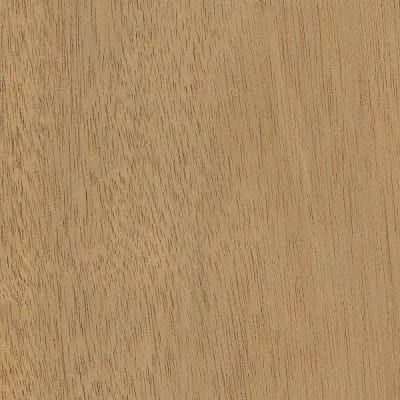
Genuine Mahogany (Swietenia Macrophylla)
We are talking about Genuine Mahogany, what used to be called Honduras Mahogany or Cuban Mahogany. The scientific name is Swietenia Macrophylla. To be very clear, there is only one Swietenia Macrophylla, one Genuine Mahogany. There are now, however, several un-genuine Mahoganies (un-genuine is probably not a real word but unless you’re an Eng. Lit. professor, just roll with it if you can).
Genuine Mahogany (also called Big Leaf Mahogany on occasion) is a prized wood species primarily due to its aesthetic beauty, exceptional stability, relative density, rot resistance and overall durability. It’s good stuff and it commands a premium as a result.
As with many premium brands or materials, there will inevitably be alternatives and look-alikes brought into the mix that, intentionally or otherwise, are characterized or presented as being “Mahogany”. This conversation is about being clear on whether you are talking about the Real Deal Genuine Mahogany or an alternative. All these alternatives are commonly presented under the ubiquitous umbrella name of “Mahogany”.
Let’s put names to some of the alternatives that often pop up under the Mahogany umbrella.
- Plantation Mahogany
- African Mahogany
- Sapele
- Sipo
- Meranti
Before we try to sort all this out, it’s valid to ask “Why sort it out at all? If it looks like Mahogany, what’s the big deal ?”. Quite a bit, as it turns out.
Genuine Mahogany demands a premium because of its proven properties and track record. You pay more but you get more. That’s a fair deal. The alternatives are in many cases very good wood species themselves, we’re not suggesting otherwise but they possess different (lesser) properties and they cost less per board foot than Genuine Mahogany.
Quote the spec, the whole spec and nothing but the spec.
On a recent comparison exercise with an architect and contractor on the east coast it turned out that of the three window bids in hand, all three were for different wood species. One was Genuine Mahogany as specified, two were alternative “Mahoganies”. All the bids were in the same ballpark, dollar-wise. But when the two alternatives were re-priced as Genuine Mahogany to accurately reflect the architects’ specifications, the prices jumped about 20%. That’s not chump change if you’re talking about a million dollars worth of custom windows.
The final purchase may not end up being Genuine Mahogany, but the due diligence process is intended to establish clarity and transparency so that the relative value of each proposal can be fairly judged in the best interests of the project.
Here’s a summary of the main characters in this plot. You can find an expanded summary here: http://www.wood-database.com/
Plantation Mahogany

Pin knot in finished Plantation Mahogany
Just to confuse things further, Plantation Mahogany can actually be Genuine Mahogany (Swietenia macrophylla), just that it is plantation grown. So what you may ask? Patience Grasshopper.
Typically, plantations produce trees that grow quickly, produce lots of branches along with wide growth rings, pin knots, and a lighter almost bleached coloring compared to natural growth Genuine Mahogany. Low density is often a concern as well. Plantations are there to produce a commercial product. The trees are harvested young, often before they mature and develop the density, resins and oils that make the wood durable. You get the Mahogany name, but you’re not getting the Mahogany properties (the same applies to Teak versus plantation Teak).
Pin knot in finished Plantation Mahogany
Plantation Mahogany sells in its raw form for prices similar to or lower than African Mahogany at time of writing. It is still a good timber – but the Buyer should a) be aware of the deviation from spec and b) get the appropriate savings in return for the substitution.
African Mahogany (Khaya genus)
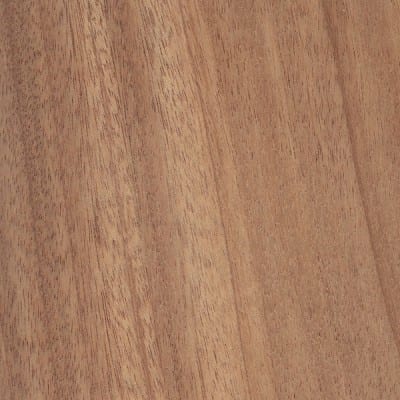
African Mahogany (Khaya Senegalensis)
African Mahogany (Khaya senegalensis)
African Mahogany isn’t one specific tree, it’s comprised of a variety of wood species within the Khaya genus. It is from a different continent and is a different species from Genuine Mahogany. That doesn’t mean its about as much use as an ashtray on a motorbike – it’s a perfectly acceptable substitute. But it’s not Genuine Mahogany.
Depending on whom you talk to, African Mahogany may or not be considered the real deal. For many folks, it’s close enough in appearance and characteristics to be an acceptable Mahogany substitute without raising eyebrows amongst anyone except purists. African Mahogany is a fair substitute in a value engineering exercise and has a lower price per board foot than Genuine Mahogany.
Sipo (commonly referred to as Sipo Mahogany or “Utile”)
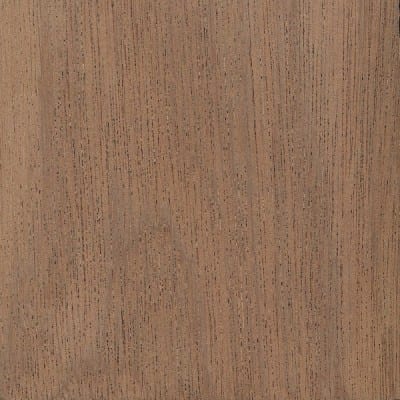
Sipo is commonly the default alternative Mahogany for German and Polish window fabricators.
Sipo or Utile (Entandrophragma utile)
Like African Mahogany, Sipo isn’t from the same genus as Genuine Mahogany though it is loosely related. Sipo is from the Meliaceae family and has similar characteristics and appearance to Genuine Mahogany though it is typically a darker tone overall and is generally considered to lack the same level of aesthetic beauty in the grain.
While Sipo presents a similar aesthetic, a primary difference is that Sipo lacks the exceptional stability of Genuine Mahogany. Stability is a critically important characteristic for window and door fabricators. Sipo isn’t unusable by any means but it isn’t comparable in this important respect. It has a noticeably lower price per board foot than Genuine Mahogany at time of writing and is a viable value engineering option when the need arises.
Meranti (also commonly called Philippine Mahogany or “Lauan”)
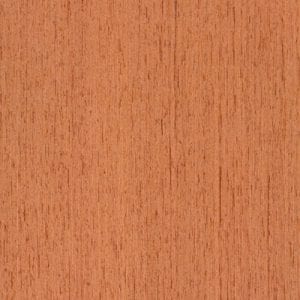
Meranti is commonly the default alternative Mahogany for Italian window fabricators.
We’re stretching it a bit here to try to present Meranti as a Mahogany. Meranti is from the Shorea genus and originates in south-east Asia. When talking about it as an alternative to Genuine Mahogany, we’re referring to Dark Red Meranti (there are several other variations).
Meranti has a similar tone and appearance to Genuine Mahogany and comparable density but that’s about it. Meranti is rated as “moderately-durable to non-durable” in regards to both decay resistance and insect attack. As a window or door material, it is not comparable to Genuine Mahogany or to many of the other alternatives we’re discussing here. It is priced well below Genuine Mahogany and is widely available though rarely used by North American window fabricators due to the availability of better options if value engineering is requested.
Sapele (sometimes called “Sapele Mahogany”)
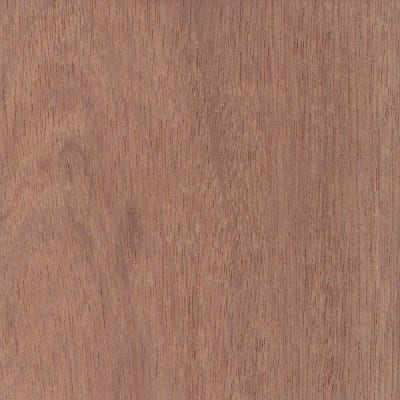
Sapele (Entandrophragma Cylindricum)
Sapele is commonly the default alternative Mahogany for North American window fabricators.
This wood originates in Africa and is the most common alternative or substitute for Genuine Mahogany in North American window fabrication. It has similar characteristics and mechanical properties to Genuine Mahogany though is generally darker in tone and has a more variable grain pattern along with a greater propensity for dark “Tiger” stripes.
Sapele is widely known and understood by architects who specify high-end wood windows and because it is an excellent wood in its own right, it’s usually presented as Sapele rather than a Mahogany wanna-be. Sapele is a lower price per board foot than Genuine Mahogany – around 12% less thereabouts at time of writing.
So – we’re good to go now, right?
It really is just a question of Caveat Emptor. While it shouldn’t be up to the architect or contractor to know all this stuff about Mahogany, it currently is in many instances. Most of the time the misuse of the Mahogany name is hopefully not a deliberate attempt to deceive, it’s just become “standard practice” in a market where more windows end up being built from a Mahogany alternative than from Genuine Mahogany. That’s understandable, but you would prefer to know what you’re buying first, right?
Architects and contractors who want Genuine Mahogany can shortcut the labyrinth. The spec could be written as “Genuine Mahogany – Swietenia Macrophylla” – alternates, including plantation Mahogany to be presented as Alternates with species genus noted as such”.
With everyone on the same page, you can then assess apples to apples more exactly. But the navigation of the Mahogany labyrinth is do-able so we hope that helps.
Talk to your window and door fabricator and have them hold the spec, the whole spec and nothing but the spec — if that is what you have asked for.
Links: Read more about Mahogany | Download this article as a PDF




